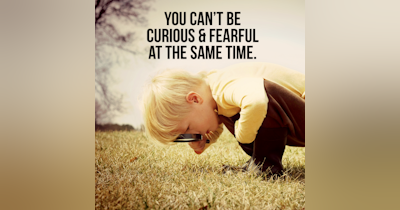It seems the older that we get, the safer we become. It sounds logical, but it is leaving you vulnerable. Few options mean fewer opportunities. Taking risks is one of the safest things you can do in your life because it creates options, teaches lessons, and develops grit, confidence, discipline, momentum, and results.
Get rid of the sniper mentality.
I am not sure when it happens, but somewhere along the way, we go from playing wide open-grabbing anything and everything to playing it safe and move to a one-shot-one-kill mentality. You become selecting in what opportunities you're willing to take and who is worth your time.
I see this happen all of the time in sales. When a new salesperson starts, they believe that every customer will buy if not today, they'll be back (we call them "be-backs") one day. As the rejection mounts up, so too does the doubt and that new salesperson turned veteran salesperson sees every lead, phone call, and customer as a threat and no longer an opportunity.
Much like salespeople, entrepreneurs do a similar thing. They go after the one big account that will pay huge commissions and drop the smaller accounts along the way. The problem is once you have to increase your overhead to service the increasing demands of that one account, your margins shrink, your service stinks, and the increasing concessions you have to make squeeze you right out of business.
Write this on your bathroom mirror.
Safe is risk. Risk is safe.
Sales and life is a numbers game. Period. The more numbers you have to work with, the better your results will be over the long haul.
What's in your bucket?
Imagine at the beginning of the month I hand you a large bucket and give you no other instructions other than to go fill it throughout the month.
The person who takes risks, not only fills the bucket, but asks for another one while the person playing it safe only needs one bucket.
At the end of the month, I tell both of them, I will pay them for what is in their buckets. Good or bad-it doesn't matter. The one who filled up multiple buckets is about to get paid! He's giddily laughing as he backs up his Ram truck, drops his tailgate, and dumps out all of his buckets while the person who played it safe, pulls only a few items out of his bucket.
This is how you need to see how taking risks creates opportunities. Taking more risks, creates more opportunities.
Let's go back to the bucket analogy so that I can show you how opportunities are created.
Let's say the guy who took risks had 50 opportunities in his bucket. Let's scrape half of them (25) to the left and the other 25 to the right.
The 25 on the left are prime opportunities. Out of the 25, fifteen of them do business with you; 5 aren't qualified, and the other 5 are hot, but not quite ready.
But wait there's more! (In my Ginzu knife commercial voice). Remember the other 25 that we carved off to the right? Out of that 25, 10 of those are warm, but not ready and the other 15 drop out. (Bought elsewhere, changed their mind, or not qualified.)
The following month, I start with 5 who are hot, but not ready, 10 who are warm and need to be followed up with PLUS I'm putting a brand new 50 in my new bucket. If you do this month after month, you're going to need to hire an assistant!
This is how you keep your pipeline full and beat back discouragement because every opportunity is just another one in your bucket. So even if you spent 3 days or 5 hours and they don't do business with you, say, "Bucket!" and keep it moving.
But wait there's more! (In my Ron-Co Rotisserie Chicken oven voice)
Now that we we've created options, let's talk about the lessons from each one of those opportunities. Every opportunity carries with it 4-5 lessons. MINIMUM!
After each encounter ask yourself:
How well did I communicate? Was I clear, articulate, and prepared?
Was I curious? Did I ask questions are draw assumptions?
Was I creative? Did I spin the rejection and create other perspectives and offer alternative solutions?
Do I have a better understanding of the client's need than before?
Did I confront productively? When met with resistance, did I productively challenge their objection or stall? (& not turn beet red looking like I want to fight)


